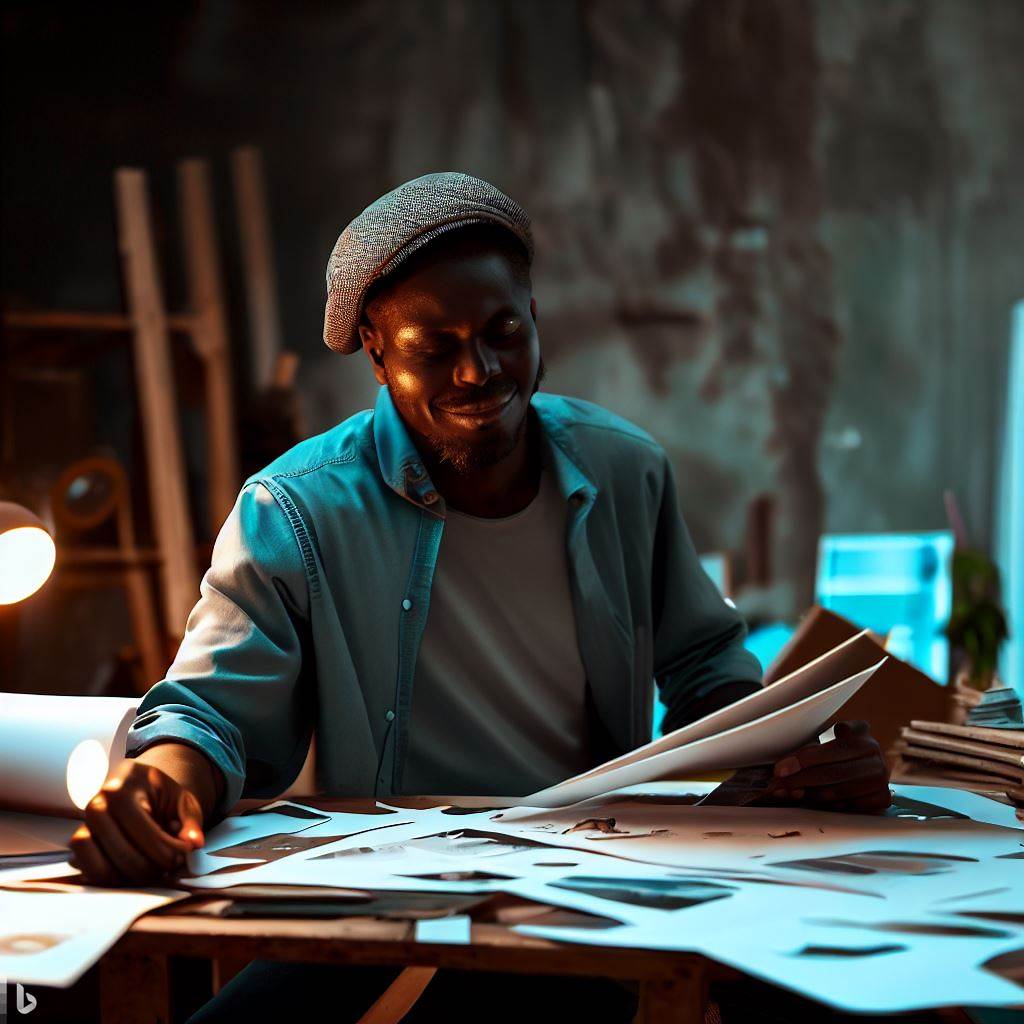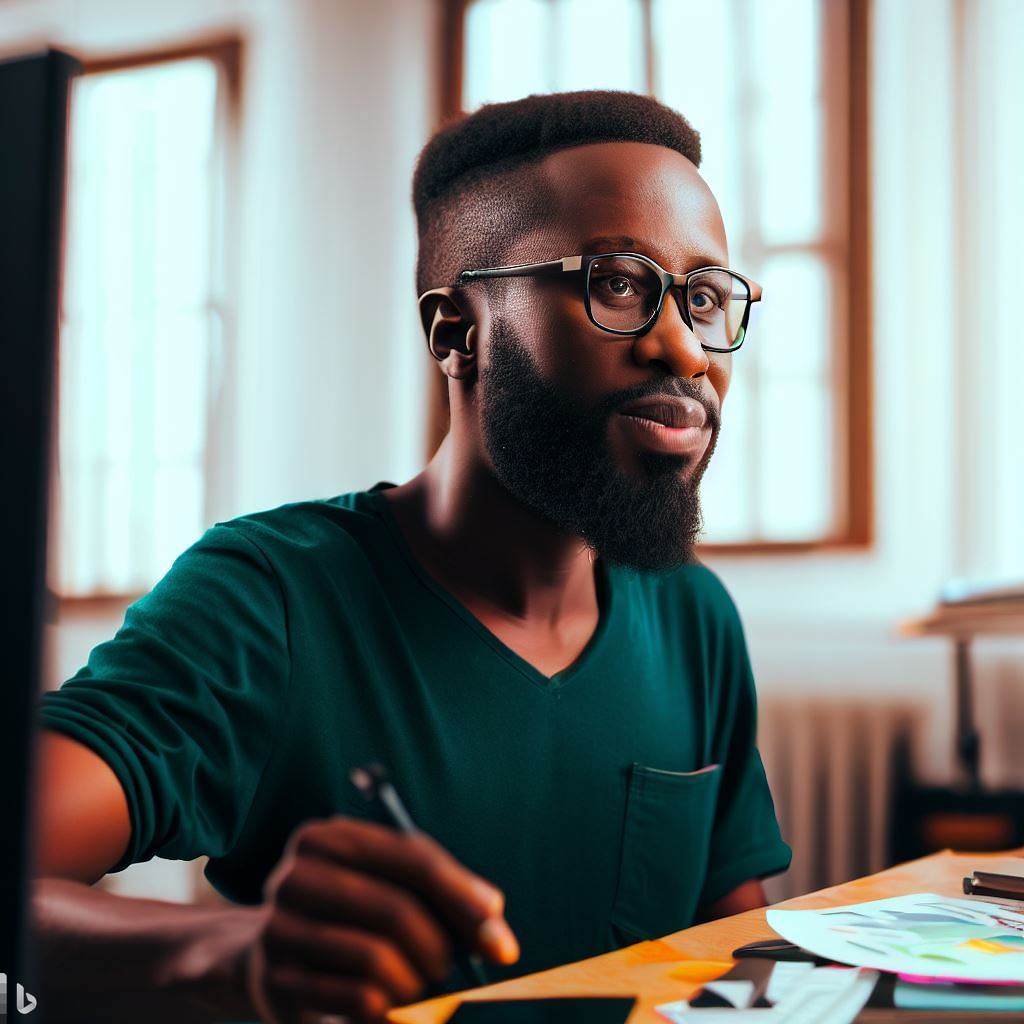Introduction
A production designer is responsible for creating the visual concept of a film or television production.
Building a portfolio is crucial for a production designer in Nigeria to showcase their skills and experience.
By having a portfolio, production designers can demonstrate their abilities to potential employers and clients.
A well-curated portfolio acts as a visual representation of a production designer’s creativity and innovation.
It allows them to exhibit their proficiency in designing sets, costumes, props, and overall aesthetics.
An impressive portfolio also helps production designers stand out in a competitive industry like Nigeria.
It provides a platform to highlight unique and culturally significant elements that can add value to a project.
Moreover, a portfolio enables production designers to document their work and track their artistic growth.
Having a diverse portfolio demonstrates versatility and the ability to work on various types of productions.
In a digital age, having an online portfolio allows production designers to reach a wider audience.
It is a valuable tool to convey their artistic vision, style, and storytelling abilities to potential collaborators.
Therefore, building a portfolio as a production designer in Nigeria is vital for professional growth and recognition in the industry.
Importance of a Portfolio for Production Designers
As a production designer in Nigeria, building a portfolio is crucial for your success in the industry.
A portfolio is not just a collection of your work; it is a powerful tool that showcases your skills, creativity, and professionalism.
1. Demonstrates Your Skills
A portfolio allows you to exhibit your expertise and capabilities in production design.
By including a wide range of projects, you can demonstrate your versatility and adaptability in different styles and genres.
Potential clients and collaborators can assess your skills based on your previous work, making it easier for them to trust you with their projects.
2. Showcases Your Creativity
A well-designed portfolio can serve as a platform to showcase your creativity in various aspects of production design.
Whether it’s set design, props, or costumes, you can curate your work to highlight your unique ideas and innovative solutions.
This can spark the interest of potential clients who are looking for fresh and creative perspectives.
3. Attracts Potential Clients and Collaborators
Your portfolio serves as a visual representation of your abilities.
It allows potential clients and collaborators to get a glimpse into your style and understand how you can contribute to their projects.
A well-curated portfolio can attract attention and generate interest, leading to new opportunities and partnerships.
4. Establishes Your Professionalism
A portfolio is a professional document that showcases your ability to handle projects in a structured and organized manner.
It demonstrates your attention to detail, commitment to deadlines, and ability to work within budget constraints.
This level of professionalism is essential for building trust with clients and securing future projects.
5. Keeps Your Work Organized
By creating a portfolio, you can keep your work organized and easily accessible.
It allows you to showcase your projects in a visually cohesive and structured manner, making it easier for clients to navigate and understand your body of work.
You can categorize your projects based on genres, styles, or any other relevant criteria, enabling potential clients to find exactly what they are looking for.
6. Enables Continuous Growth and Improvement
A portfolio is not a static document; it is a reflection of your growth and improvement as a production designer.
Regularly updating your portfolio with new projects and experiences showcases your commitment to personal and professional development.
It also helps you identify areas for improvement and serves as a benchmark for measuring your progress over time.
In the competitive world of production design in Nigeria, a portfolio is an invaluable asset.
It has the power to attract potential clients and collaborators, showcase your skills and creativity, and establish your professionalism.
Building a comprehensive and well-curated portfolio can open doors to exciting opportunities and propel your career to new heights.
Read: Top Graphic Design Schools and Courses in Nigeria: A Guide
Starting Your Portfolio
Organizing and Planning Your Portfolio
Having a well-organized and carefully planned portfolio is crucial for any production designer in Nigeria.
It serves as a visual representation of your skills and abilities to potential employers and clients.
Here are some important points to consider:
- Determine your target audience: Before you start building your portfolio, it’s essential to identify who you want to impress.
Are you targeting film directors, event planners, or advertising agencies? Knowing your audience will help you tailor your portfolio accordingly. - Establish a clear structure: Divide your portfolio into sections to make it easier for viewers to navigate.
Consider including sections such as concept art, set designs, mood boards, and any other relevant categories that highlight your strengths. - Showcase versatility: As a production designer, it’s essential to demonstrate your ability to work on a variety of projects.
Include examples from different genres, such as historical dramas, sci-fi films, or contemporary events, to showcase your adaptability. - Highlight your best work: It’s important to carefully select the examples you include in your portfolio.
Choose pieces that best represent your unique style and technical skills. Quality is more important than quantity, so be selective and showcase your strongest work.
Included Sections in a Production Designer’s Portfolio
A production designer’s portfolio should include various sections that provide a comprehensive view of their capabilities.
Here are some sections you should consider incorporating:
- Concept art: This section should showcase your ability to translate ideas and concepts into visual representations.
Include sketches, digital artwork, or any other visual materials that highlight your creativity and imagination. - Set designs: Showcasing your skills in designing sets is essential. Include examples of your set designs, floor plans, and renderings to demonstrate your ability to create immersive environments for film, stage, or events.
- Mood boards: Mood boards are a great way to communicate the overall visual style and atmosphere of a project.
Include a selection of mood boards that effectively capture different moods and aesthetics to demonstrate your range as a production designer. - Storyboards: Storyboards help visualize the flow of a narrative and how scenes will visually come together.
Including storyboards in your portfolio showcases your storytelling abilities and helps potential clients understand your creative approach.
Tips for Selecting the Best Examples of Your Work
Choosing the right examples for your portfolio can make a significant impact on how potential employers or clients perceive your skills.
Here are some tips to help you select the best work to include:
- Show diversity: Include examples from different projects to demonstrate your versatility. Show that you can work in various genres and adapt your style to different visual narratives.
- Highlight your strengths: Identify your unique strengths as a production designer and select pieces that showcase those strengths. This will help you stand out and leave a lasting impression.
- Keep it relevant: Focus on including work that is most relevant to the projects you aspire to work on. Tailor your portfolio to the specific needs and expectations of your target audience.
- Show the process: Don’t just include the final designs; show the progression of your work. Include sketches, iterations, and behind-the-scenes photos to demonstrate your creative process and problem-solving skills.
In fact, building a portfolio as a production designer in Nigeria requires careful planning and organization.
By considering your target audience, showcasing the right sections, and selecting the best examples of your work, you can create a compelling portfolio that effectively highlights your skills and abilities.
Remember, your portfolio is a reflection of your creative voice and should leave a lasting impression on those who view it.
Read: Women in Production Design: A Focus on Nigeria
Showcasing Projects and Collaborations
Importance of Displaying Completed Projects in Your Portfolio
The first step in building a successful portfolio as a production designer in Nigeria is to showcase your completed projects.
Displaying your work allows potential clients and employers to see your skills and capabilities in action.
By including a variety of projects, such as films, TV shows, theater productions, or music videos, you can demonstrate your versatility as a production designer.
A well-curated portfolio not only shows your ability to design visually appealing sets but also highlights your attention to detail and problem-solving skills.
Highlighting Collaboration Experiences
In addition to showcasing your individual projects, it is important to highlight your collaboration experiences in your portfolio.
Working effectively with directors, producers, and other creative team members is crucial in the production design field.
Including a section in your portfolio that emphasizes your collaborative skills demonstrates your ability to work well within a team.
You can discuss the different roles you played in the collaborations, such as collaborating with costume designers, cinematographers, or art directors.
Different Ways to Showcase Projects
There are various ways to present your projects in your portfolio to make them visually appealing and engaging for the viewer.
One effective method is to include before and after photos of your set designs to demonstrate the transformation you achieved.
Another option is to include behind-the-scenes footage or time-lapse videos that provide a glimpse into the process of creating the set.
Client testimonials are also a powerful way to showcase your accomplishments and the satisfaction of your clients.
Additionally, you can include sketches, mood boards, or concept art alongside the final set designs to demonstrate your creative process.
Using a mix of these techniques will give a comprehensive view of your skills and experiences as a production designer.
In conclusion, building a portfolio as a production designer in Nigeria requires showcasing your completed projects and collaboration experiences.
A well-curated portfolio enhances your chances of attracting potential clients, employers, and collaborators.
By including before and after photos, behind-the-scenes footage, and client testimonials, you can effectively demonstrate your skills and creativity in production design.
Remember, a great portfolio is not just a collection of projects, but a reflection of your talent, professionalism, and ability to collaborate with others.
Read: The Role of Graphic Designers in Nigeria’s Advertising Industry

Adding Personal Touches to Your Portfolio
As a production designer in Nigeria, building a portfolio is essential for showcasing your work and attracting potential clients.
However, a portfolio shouldn’t just be a collection of your projects; it should also reflect your unique style and personality.
Adding personal touches to your portfolio can help you stand out from the competition and make a lasting impression on viewers.
Importance of Adding Personal Touches
When potential clients browse through portfolios, they are not just looking for someone who can complete a project; they are also looking for someone whose style aligns with their vision.
Adding personal touches allows you to communicate and express your artistic identity. It enables you to show the world what sets you apart from other production designers in Nigeria.
By infusing your portfolio with your personal style, you can create a cohesive brand that reflects your aesthetics and preferences.
This branding helps clients understand your design philosophy and gives them confidence in your ability to execute their projects.
Benefits of Creating Unique Branding
Building a unique branding for your portfolio has several advantages.
Firstly, it helps you establish a memorable identity in the minds of clients. When they think of your name or see your logo, they will associate it with your distinctive style, making it easier for them to recall your work.
A unique branding also signals professionalism. It shows that you have invested time and effort into creating a cohesive and visually appealing portfolio.
This attention to detail can help build trust among clients, as they perceive you as someone who pays attention to even the smallest aspects of your work.
Moreover, a unique branding allows you to differentiate yourself from competitors. In a saturated industry like production design, standing out is crucial.
By creating a distinctive visual identity, you can position yourself as a top choice for clients seeking a fresh and innovative design approach.
Infusing Personal Touches into Your Portfolio
There are several ways you can add personal touches to your portfolio and make it truly your own.
One approach is to focus on selecting projects that resonate with you on a personal level.
By showcasing projects that reflect your interests and passions, you can bring a unique perspective to your portfolio.
Another way to infuse personal touches is through the design and presentation of your portfolio.
Consider using a color scheme, typography, or layout that represents your style.
You can also incorporate elements that reflect your cultural heritage or showcase your attention to detail through intricate illustrations or graphics.
Furthermore, don’t be afraid to include a brief introduction or artist statement on your portfolio website or in your physical portfolio.
This allows you to share your design philosophy, inspirations, and aspirations with viewers, giving them a deeper understanding of your work.
Publish Your Professional Profile, Business or Brand
Showcase your expertise, gain trust, and boost visibility instantly on Professions.ng.
Publish NowIn short, adding personal touches to your portfolio is essential for any production designer in Nigeria.
It helps you establish a unique brand, stand out from competitors, and communicate your style and personality to potential clients.
By infusing personal touches into your portfolio design and presentation, you can create a lasting impression and increase your chances of success in the industry.
Read: Legal Requirements for Production Designers in Nigeria
Promoting Your Portfolio
As a production designer in Nigeria, it is crucial to promote your portfolio to gain visibility and attract potential clients.
Here are some effective ways to promote your portfolio:
- Use online portfolio websites like Behance, Dribbble, and ArtStation to showcase work globally.
- Build a social media presence on Instagram, Facebook, and Twitter to engage a broader audience.
- Develop a personal website for complete control over your portfolio presentation and a central hub for your work.
Your online presence plays a significant role in promoting your portfolio:
- Enhance visibility with an accessible online portfolio.
- Display versatility, creativity, and expertise.
- Engage directly with potential clients on social media, fostering new projects and collaborations.
Networking is an essential aspect of building a successful career as a production designer.
Here are some networking opportunities and events to consider:
- Attend film, design, and creative industry conferences for networking and trend insights.
- Join workshops led by seasoned production designers to boost skills and connections.
- Engage with potential clients at film festivals, fostering project opportunities.
Additionally, utilizing social media platforms can further help you gain exposure:
- Engage with the Community: Join online groups, forums, and communities related to production design to connect with like-minded individuals and potential clients.
- Collaborate with Filmmakers: Reach out to filmmakers and offer your services proactively to build relationships and expand your portfolio.
- Share Behind-the-Scenes Content: Post behind-the-scenes photos, videos, and insights on social media, showcasing your creative process and giving potential clients a glimpse into your work.
Always remember to update your portfolio regularly with new projects and keep your online presence active.
Actively seek opportunities to showcase your work, whether through online platforms or physical exhibitions.
In summary, promoting your portfolio as a production designer in Nigeria requires utilizing online platforms, having an active online presence, and engaging in networking opportunities.
By harnessing the power of the internet and social media, you can gain exposure, attract clients, and establish yourself as a reputable production designer.
Updating and Evolving Your Portfolio
As a production designer in Nigeria, building a strong portfolio is essential to showcase your talent and attract potential clients.
However, creating a portfolio is not a one-time task; it requires regular updates and maintenance to stay relevant and competitive in the industry.
In this section, we will discuss the importance of updating and evolving your portfolio, emphasizing the need for growth and progress in your work.
Additionally, we will provide valuable tips on how to evaluate and improve your portfolio over time.
Emphasize the need for regular updates and maintenance of your portfolio
- Keep your portfolio up to date to reflect your current skills and abilities.
- Remove outdated or weaker pieces to maintain a high-quality collection of work.
- Regular updates show that you are active in the industry and committed to your craft.
Discuss the importance of showcasing growth and progress in your work
- Include a range of projects that demonstrate your ability to handle different styles and genres.
- Showcase your development as a production designer by including older and newer pieces.
- Highlight the challenges you faced in specific projects and how you overcame them.
Provide tips on how to evaluate and improve your portfolio over time
- Regularly review your portfolio and seek feedback from trusted peers or mentors.
- Consider updating your portfolio based on industry trends and changing client preferences.
- Identify any gaps in your portfolio and actively seek projects to fill those gaps.
- Experiment with new techniques and styles to keep your portfolio fresh and diverse.
- Stay open to constructive criticism and constantly strive for improvement.
Remember, your portfolio is a reflection of your skills, creativity, and professionalism.
It is crucial to regularly update and evolve it to stay competitive in the dynamic field of production design in Nigeria.
By showcasing growth and progress in your work and actively seeking feedback and improvement, you can create a portfolio that captivates potential clients and opens doors to exciting opportunities in the industry.
Conclusion
Building a portfolio as a production designer in Nigeria is extremely important.
It is a reflection of your skills and showcases your ability to potential employers. It helps you stand out in a competitive industry.
I encourage aspiring production designers to start compiling their portfolios and showcasing their skills.
It is a way to gain recognition and attract opportunities in the industry.
Remember, your portfolio is a powerful tool that can open doors for you.
As you embark on this journey, stay motivated and keep improving your skills. Believe in yourself and your artistic vision.
The road to success may have obstacles, but with determination and hard work, you can achieve your dreams.
So, go ahead, start building your portfolio, and let your creativity shine. You have what it takes to be a successful production designer in Nigeria.
Believe in yourself and keep pushing forward.
The industry is waiting for your talent, so go out there and make your mark. Good luck!




